Outlining Resources
Outlining Resources
Nanowrimo Prep Workbook (outlining: session 3, page 19)
Choosing the Best Outlining Method for You
Outline Your Story Like a Subway Map
How to Build a Plot from an Idea
How to Build a Plot from Characters/Setting
~~~
~Grand List of Writing Resources~
More Posts from Lune-versatile and Others






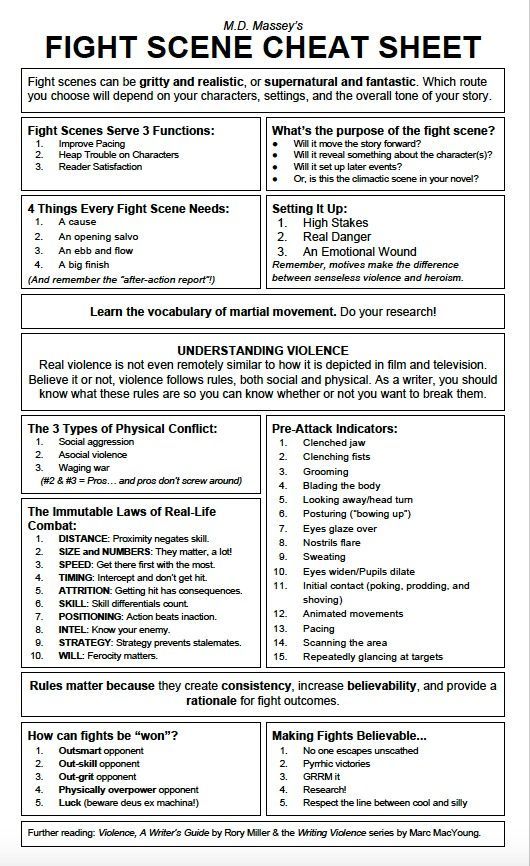
Writing tool for your fight scenes.
The right FREE tools to write a book
hello hello, it's me!
today I was thinking of how much you loved my masterlist featuring some free tools for writers, and I thought I would do something like that again but, this time, featuring just one or two tools per step while getting the best of "the writer's workbook" (which is also free).
before going any further, for those who don't know, "the writer's workbook" is, as the name says, a workbook for writers, with over 90 pages. it has lots of sheets divided into categories, to help you build the skeleton of your novel. (know more about it here).
however, we can get the most out of it using other complementary tools to ease this process.
Brainstorming
Reedsy generator - it's one of my favorites, and it can be quite useful when you're stuck and want to get an idea. you're free to make changes to it so that it is as unique as possible.
Mindmap
Lucidspark - although it has a premium version, I find it so helpful when it comes to making a mindmap. I've used it multiple times before, including for college assignments, and it's one of the best I've found so far.
Mindmup - I'm sharing this one here as an alternative to lucidspark, since this one doesn't require to create an account, and you have access to unlimited maps. however, in my opinion, it is not as good or intuitive as lucidspark is.
Come up with names
Behind the name - it's a classic, but one of my favorites. you can search every name you could ever imagine, and get its meaning, history, variations, etc. it still has some tools you can use such as a name generator, anagrams, and much more.
Make a profile
Fake person generator - although it was not created for authors, you might find it useful since it gives lots of details and you can be interested in some fields.
Character generator - this one was made for writers, and is simple and easy to use.
Family tree
Family echo - it's so simple yet so helpful.
Maps
Inkarnate - it has a paid version, but you can use it for free and create a great map.
Politics
Filteries - this is sooo complete and accurate!
hope this was helpful! have a nice day <3

Tips for writing an essay with executive dysfunction: do this.
Write out bits and pieces of the essay. When you get to a part you can’t/”don’t want to” write, put it in bold brackets. Get as much done as you can and come back in a half an hour or so!
If the executive function is still bothering you, take it one bracket at a time. Don’t delete the bracket until you’re done “filling it in,” so to speak. If you need to take more breaks or hop to the next bracket, you can do that too! Similarly, if you have a thought you want to get down but you aren’t sure how to word it, put it in bold brackets as well!
It may not “cure” the executive dysfunction or procrastination problems, but it makes writing the essay more like putting shapes in holes of the same shape. It can be a pain, but the process is a bit more streamlined and user-friendly.
I know this may not work for everyone, but as someone who has really bad executive dysfunction and problems focusing (thank you, ADHD!) this works REALLY well for me! I hope by sharing it it can help other people (with and without executive dysfunction/adhd) too! o/
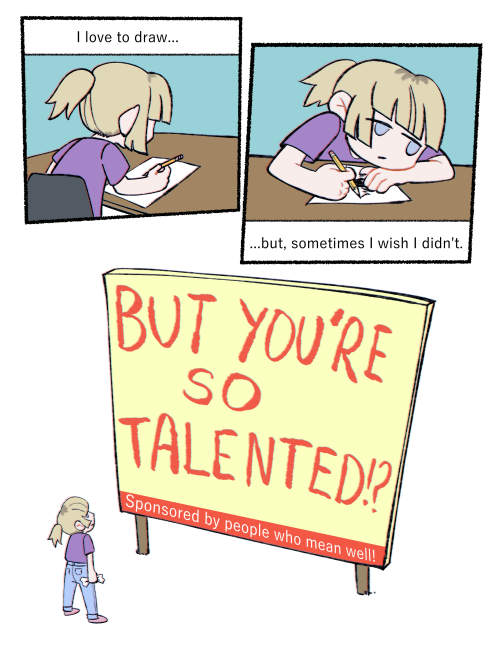
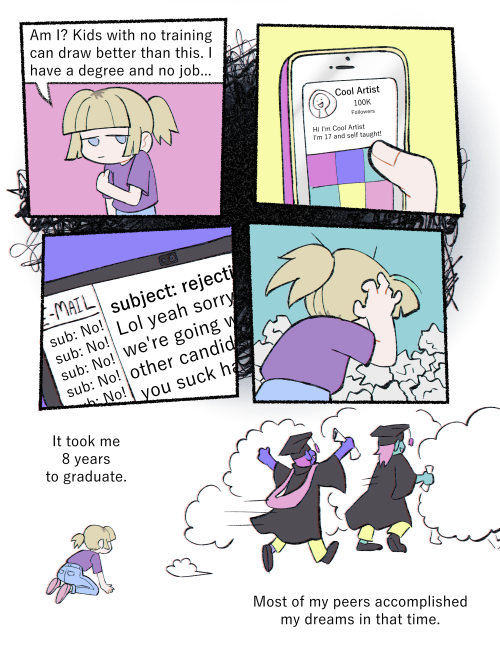
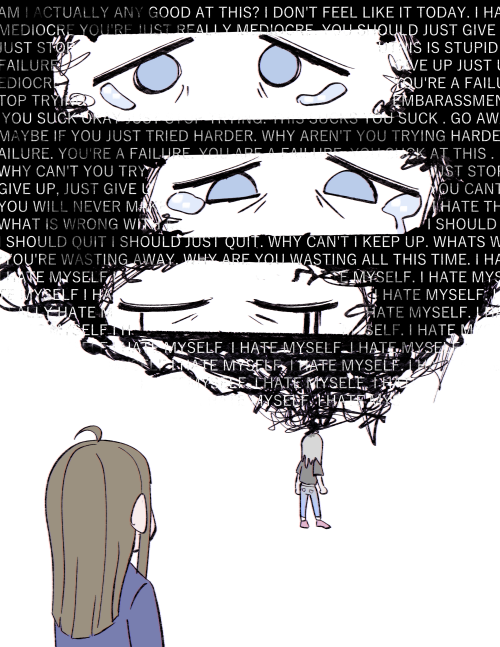
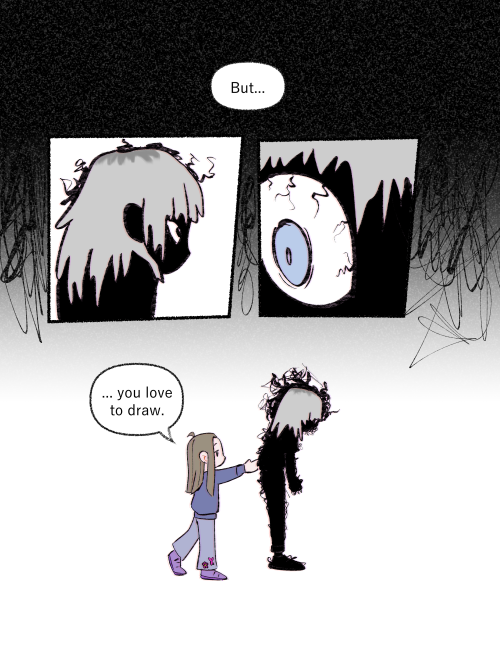
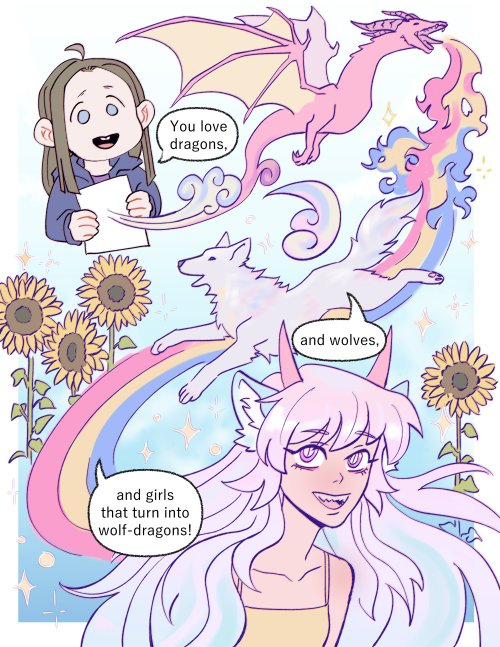
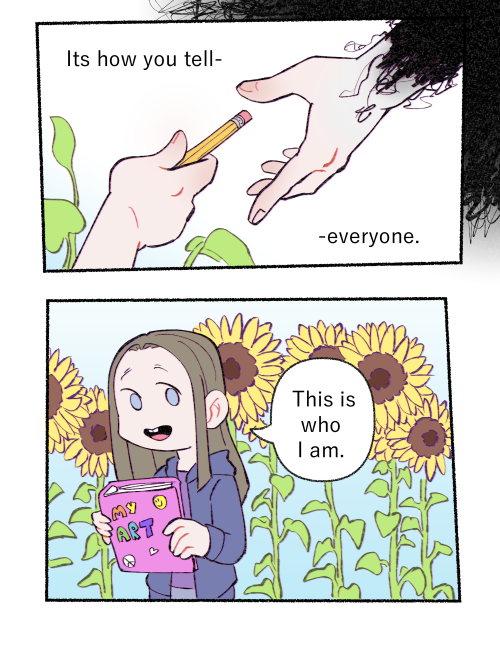

A comic to try and sort through some difficult feelings about being an artist and a reminder to not forget who you are.
Character Development : A Collection of Resources

Patreon || Ko-Fi || Masterlist || Work In Progress
–
Resources
Resources For Creating Characters
Resources For Describing Characters
Resources For Writing The Mafia
Resources For Writing Royalty
Commentary on Social Issues In Writing
General Tips
Guide to Character Development
How To Fit Character Development Into Your Story
Tips on Character Consistency
Designing A Character From Scratch
Making characters for your world
Characters First, Story Second Method
Understanding Your Character
Tips on Character Motivations
31 Days of Character Development : May 2018 Writing Challenge
How To Analyze A Character
Alternative Method of Character Creation
Connecting To Your Own Characters
Interview As Your Characters
Flipping Character Traits On Their Head
Character Driven vs. Plot Driven Stories
Traits
Tips On Writing About Mental Illness
Giving Your Protagonists Negative Traits
Giving Characters Distinct Voices in Dialogue
Giving Characters Flaws
Making Characters More Unique
Keeping Characters Realistic
Archetypes
Writing Good Villains
Creating Villains
Guide to Writing The Hero
Positive Character Development Without Romanticizing Toxic Behavior
Tips on Writing Cold & Distant Characters
Balancing Multiple Main Characters
Creating Diverse Otherworld Characters
Foreshadowing The Villain
–
Masterlist | WIP Blog
If you enjoy my blog and wish for it to continue being updated frequently and for me to continue putting my energy toward answering your questions, please consider Buying Me A Coffee, or pledging your support on Patreon, where I offer early access and exclusive benefits for only $5/month.
Shoutout to my $15+ patron, Douglas S.!
The “What-If” Writing Method
Sometimes when I’m writing, brain just....stops. No more ideas. No more words. Nothing. Sometimes, the solution to this problem is to simply take a break from writing and let your brain relax. Other times, though, you really are just at a block for ideas. This happened to me significantly more often than I would like, but thankfully, I’ve developed a solution that works well for me, and it’s uncreativly titled the “what-if” method.
Get a piece of paper and pen. Or a Google doc, or whatever works best for you.
Start brainstorming questions about your story, or possible “what-if” scenarios. (Ex: What if my character got framed for a crime they didn’t commit?)
Write down every single idea that comes to your head. Even if it doesn’t really work for your story. Even ones that deviate from your existing plot. Even the stupid ones. Especially the stupidest ones.
Cross out the ideas you don’t like, circle the ones that you do like.
Start coming up with answers for the questions you circled, or expand in the by coming up with more questions. (Ex: They would have to prove they didn’t commit the crime to regain their freedom. How do they prove it?)
Repeat until you have a full idea that you can work on/write with.
That’s it. That’s the whole strategy. I’ve used this a million times, and it’s gotten me out of a million cases of writers block, so hopefully it can work well for you too! Happy writing!
Finish Your Drafts (please)
I have this really bad habit of getting most the way through a draft, seeing how it needs to change structurally and… starting a new one. I have countless unfinished drafts and shorts and written out ideas that haunt me with their cut off sentences and half paragraphs.
Here’s the part that sucks. Finishing a draft is always worth it. Always. No matter how messed up your beginning may be, how much you need to rework or change, how much just isn’t coming together. Get through to the end, even if you have to write a bunch of stuff you aren’t proud of to get there, get through to the end.
I learned more about my novel from one finished draft than I did from the five unfinished ones after it. You need to explore your ending, because your ending is the most important part of the entire piece.
This month we explored outlining and character arcs—all of that planning, all of that work we’ve put into this project leads up to the ending. The ending will tell you more about your direction and how the pieces you’ve tried to put together are working than anything else. It’s the one place you can’t hide. Either the ending wraps up how you want it to, or you need to go back to the drawing board.
I almost didn’t finish that one draft. I knew there was a huge gaping problem I hadn’t noticed before right in the middle and that I had to rework some stuff. I nearly stopped there, but I pushed forward instead. It was there that I discovered a large part of that problem was the ending I had planned. I was working towards the wrong thing, so of course the middle would fall apart.
You’ll be able to see your character arcs, your theme, your subplots, all of it needs to be addressed in the ending, so your ending is going to tell you what is working and what isn’t.
Push through to the finish line. Best case scenario you understand your work and process on a deeper level. Worst case, you have a finished draft—and that’s always something to be proud of.
Good luck! Happy end of February. Next month we’ll be talking about some other ways to create characters and voice, amongst other things. I’m looking forward to it!


Your narrator and each of your characters should sound different from one another (unless your story is in the first person and one of the characters is actually telling the story!). Remember that no two people speak in exactly the same way, so if all your characters sound identical to your narrator, it will pull the reader out of the story.

Every person has distinct vocal habits or “go-to’s,” words or phrases they use often, and giving your characters their own vocal “go-to’s” can help lend them some realism and make it easier to tell them apart from one another. Here’s a little hint: we use these “go-to’s” even more often when we’re distracted or not fully paying attention to the conversation and what we’re saying.

People sometimes stumble over their words. Let your characters stutter, or repeat themselves, or forget what they were about to say, or even ramble sometimes, especially if they are feeling flustered or overwhelmed in the scene. This will add realism to your dialogue, and make your characters seem more real to your readers!

Just like in real life, the situation should affect how your character speaks. For example, if a character has just gotten a big, unpleasant surprise, they probably won’t be in the right frame of mind to make a calm, articulate speech. Think about what’s happening and how it will affect what your character says and the way that they say it.

Most people speak differently depending on who they are talking to. For example, you probably wouldn’t talk to your boss the same way you would talk to a friend! Think about your character’s relationship to the person they’re talking to, and how they feel about that person, and let that come out in their dialogue.

Descriptive verbs (like “exclaimed” or “demanded” instead of “said”) are a great way to breathe some life into your dialogue, because they give the reader more information, telling us not just what the character said but how they said it. On the other hand, when used too often, or incorrectly, descriptive verbs can pull the reader right out of the story (for example, using “demanded” when the character isn’t making any kind of demand in their dialogue).
-
 stephendorff reblogged this · 6 months ago
stephendorff reblogged this · 6 months ago -
 ref-writing reblogged this · 1 year ago
ref-writing reblogged this · 1 year ago -
 autumnsscribbles reblogged this · 1 year ago
autumnsscribbles reblogged this · 1 year ago -
 honeyperched liked this · 1 year ago
honeyperched liked this · 1 year ago -
 alexathestupidwriter liked this · 1 year ago
alexathestupidwriter liked this · 1 year ago -
 theeccentricraven reblogged this · 1 year ago
theeccentricraven reblogged this · 1 year ago -
 theeccentricraven liked this · 1 year ago
theeccentricraven liked this · 1 year ago -
 aaustinwrites reblogged this · 1 year ago
aaustinwrites reblogged this · 1 year ago -
 martialwriter liked this · 1 year ago
martialwriter liked this · 1 year ago -
 aplainrose liked this · 2 years ago
aplainrose liked this · 2 years ago -
 kaileycheyenne779 liked this · 2 years ago
kaileycheyenne779 liked this · 2 years ago -
 cactus-bug liked this · 2 years ago
cactus-bug liked this · 2 years ago -
 fjshii liked this · 2 years ago
fjshii liked this · 2 years ago -
 pierrotgnome liked this · 2 years ago
pierrotgnome liked this · 2 years ago -
 celestial-maid3n reblogged this · 3 years ago
celestial-maid3n reblogged this · 3 years ago -
 gotdreamsagain liked this · 3 years ago
gotdreamsagain liked this · 3 years ago -
 angelicistics liked this · 3 years ago
angelicistics liked this · 3 years ago -
 evansyhelp reblogged this · 3 years ago
evansyhelp reblogged this · 3 years ago -
 historyo-ffuture reblogged this · 3 years ago
historyo-ffuture reblogged this · 3 years ago -
 filmsvalmont liked this · 3 years ago
filmsvalmont liked this · 3 years ago -
 evansyhelp liked this · 3 years ago
evansyhelp liked this · 3 years ago -
 rogue-16-main liked this · 3 years ago
rogue-16-main liked this · 3 years ago -
 victoryrollsandredlips reblogged this · 3 years ago
victoryrollsandredlips reblogged this · 3 years ago -
 victoryrollsandredlips liked this · 3 years ago
victoryrollsandredlips liked this · 3 years ago -
 penguinated liked this · 3 years ago
penguinated liked this · 3 years ago -
 mabonetsamhain liked this · 3 years ago
mabonetsamhain liked this · 3 years ago -
 angeltrumpet liked this · 3 years ago
angeltrumpet liked this · 3 years ago -
 thoughpoppiesblow reblogged this · 3 years ago
thoughpoppiesblow reblogged this · 3 years ago -
 thoughpoppiesblow liked this · 3 years ago
thoughpoppiesblow liked this · 3 years ago -
 th-luckystar liked this · 3 years ago
th-luckystar liked this · 3 years ago -
 squirrelsandpretzels reblogged this · 3 years ago
squirrelsandpretzels reblogged this · 3 years ago -
 squirrelsandpretzels liked this · 3 years ago
squirrelsandpretzels liked this · 3 years ago -
 lavendererose liked this · 3 years ago
lavendererose liked this · 3 years ago -
 creative-girl liked this · 3 years ago
creative-girl liked this · 3 years ago -
 conflatea liked this · 3 years ago
conflatea liked this · 3 years ago -
 lexwritcs reblogged this · 3 years ago
lexwritcs reblogged this · 3 years ago -
 ghostsandgod liked this · 3 years ago
ghostsandgod liked this · 3 years ago -
 imwriteabouteverthing liked this · 3 years ago
imwriteabouteverthing liked this · 3 years ago -
 hecateunderground liked this · 3 years ago
hecateunderground liked this · 3 years ago -
 zolanibor liked this · 3 years ago
zolanibor liked this · 3 years ago -
 callmeforsomeovertime liked this · 3 years ago
callmeforsomeovertime liked this · 3 years ago -
 inquisitivefangirl87 reblogged this · 3 years ago
inquisitivefangirl87 reblogged this · 3 years ago

